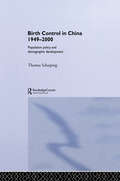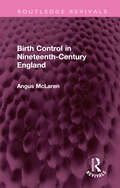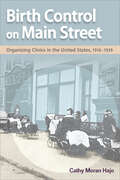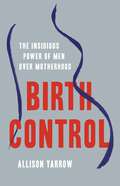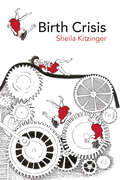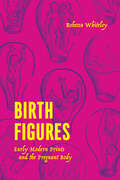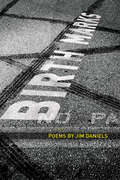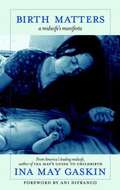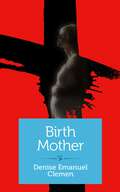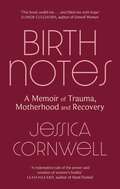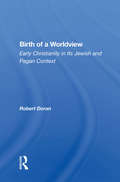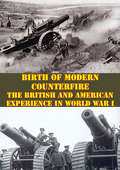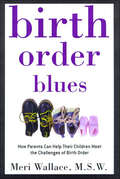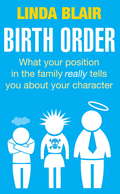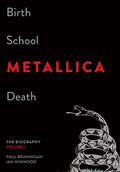- Table View
- List View
Birth Control in China 1949-2000: Population Policy and Demographic Development (Chinese Worlds)
by Thomas ScharpingThis comprehensive volume analyses Chinese birth policies and population developments from the founding of the People's Republic to the 2000 census. The main emphasis is on China's 'Hardship Number One Under Heaven': the highly controversial one-child campaign, and the violent clash between family strategies and government policies it entails.Birth Control in China 1949-2000 documents an agonizing search for a way out of predicament and a protracted inner Party struggle, a massive effort for social engineering and grinding problems of implementation. It reveals how birth control in China is shaped by political, economic and social interests, bureaucratic structures and financial concerns. Based on own interviews and a wealth of new statistics, surveys and documents, Thomas Scharping also analyses how the demographics of China have changed due to birth control policies, and what the future is likely to hold. This book will be of interest to students and scholars of Modern China, Asian studies and the social sciences.
Birth Control in Germany 1871-1933 (Routledge Revivals)
by James WoyckeFirst published in 1988, Birth Control in Germany deals in detail with the dissemination and acceptance of ideas of birth control from 1871 -1933 and shows the variety of methods that were in use-condoms, pessaries, diaphragms, caps and most notably abortion. In common with many western societies, Germany experienced a notable decline in the birth rate as it entered into the 20th century. Demographers differ in their explanation for such changes in the birth rate. Some argue that fluctuating birth rates reflect society’s efforts to match population and economy, while others argue that modern low levels can only be the result of radical innovations in popular behavior. The author argues that the latter can be shown to be the case in the German instance. He further says that attitudes quite similar to those found in liberal circles today were widespread among ordinary men and women in Germany, in contrast to, for example, the pro natalist ideologies dominant in France in the same period. This despite the regional, class and religious differentials which influence the German picture.The book amounts to an important study of the sexual politics of pre–Nazi Germany, and study in modernization of a traditional society. This is an important historical work for scholars and researchers of German history, women's studies, health & reproductive history, European history, and gender studies.
Birth Control in Nineteenth-Century England (Routledge Revivals)
by Angus McLarenThe decline of the British birth rate was arguably the most important social change to occur in the last decades of the nineteenth century, but historians have shown remarkably little interest in the phenomenon. Most of the work done on the question has been by sociologists and reflects their assumption that the progressive adoption of birth control was largely a matter of the lower classes aping the behaviour of their ‘betters’. Originally published in 1978, this book argues against this interpretation. It contends that the great interest of the nineteenth-century birth control debate is that it reveals that there was not a growing consensus of opinion on the question of family planning but rather two cultural confrontations – the struggle of the middle-class propagandists of both left and right to manipulate for political purposes working-class attitudes towards procreation, and, on a deeper level, the clash of the differing attitudes of men and women towards the possibility of fertility control. The purpose of this study is to place the idea and practice of birth control in their social and political context, and four major factors are focused upon to this end: the first is that the birth control issue played a key role in the confrontation between Malthusians, socialists, eugenists and feminists. Secondly, the whole question of contraception led to a conflict between doctors, quacks, midwives and ordinary men and women seeking to control their own fertility. Thirdly, men and women belong to different sexual cultures and necessarily respond in different ways to the possibility of family regulation, and finally, despite the claims of some that birth control was an innovation, it was the pre-industrial forms of fertility control – including abortion – which brought the birth rate down.
Birth Control on Main Street: Organizing Clinics in the United States, 1916-1939
by Cathy Moran HajoUnearthing individual stories and statistical records from previously overlooked birth control clinics, Cathy Moran Hajo looks past the rhetoric of the birth control movement to show the relationships, politics, and issues that defined the movement in neighborhoods and cities across the United States. Whereas previous histories have emphasized national trends and glossed over the majority of clinics, Birth Control on Main Street contextualizes individual case studies to add powerful new layers to the existing narratives on abortion, racism, eugenics, and sterilization. Hajo draws on an original database of more than 600 clinics run by birth control leagues, hospitals, settlement houses, and public health groups to isolate the birth control clinic from the larger narrative of the moment. By revealing how clinics tested, treated, and educated women regarding contraceptives, she shows how clinic operation differed according to the needs and concerns of the districts it served. Moving thematically through the politicized issues of the birth control movement, Hajo infuses her analysis of the practical and medical issues of the clinics with unique stories of activists who negotiated with community groups to obey local laws and navigated the swirling debates about how birth control centers should be controlled, who should receive care, and how patients should be treated.
Birth Control: The Insidious Power of Men Over Motherhood
by Allison Yarrow"Supported by ample data and suffused with anger,&” an award-winning journalist &“convincingly recasts this country&’s maternal health care system as needlessly dehumanizing&” (New York Times Book Review). Modern medicine should make pregnancy and childbirth safer for all. But in Birth Control, award-winning journalist Allison Yarrow reveals how women are controlled, traumatized, injured, and even killed because of the traditionalist practices of medical professionals and hospitals. Ever since doctors stole control of birth from midwives in the 19th century, women have been steamrolled by a male-dominated medical establishment that has everyone convinced that birthing bodies are inherently flawed and that every pregnancy is a crisis that it alone can &“solve.&” Common medical practices and procedures violate human rights and the law, yet take place daily. Misogyny and racism, not scientific evidence and support, shape the overwhelming majority of America&’s four million annual births. Drawing on extensive reporting, expert interviews, an original survey of 1,300 mothers, and her own personal experiences, Yarrow documents how modern maternal health care is insidiously, purposefully designed to take power from women to the detriment of their physical and mental health—not just during labor, but for years after. She then shows a better way, exploring solutions both cutting-edge and ancient to—finally—return power and control to birthing people. Full of urgent insights and heartfelt emotion, Birth Control is an explosive call to action.
Birth Crisis
by Sheila KitzingerOne new mother in twenty is diagnosed with traumatic stress after childbirth. In Birth Crisis Sheila Kitzinger explores the disempowerment and anxiety experienced by these women. Key topics discussed include: increasing intervention in pregnancy the shift in emphasis from relationships to technology in childbirth how family, friends and professional caregivers can reach out to traumatized mothers how women can work through stress to understand themselves more deeply and grow in emotional maturity how care and the medical system needs to be changed. Birth Crisis draws on mothers' voices and real-life experiences to explore the suffering after childbirth which has, until now, been brushed under the carpet. It is a fascinating and useful resource for student and practising midwives, all health professionals, and women and their families who want to learn how to overcome a traumatic birth.
Birth Day: A Pediatrician Explores the Science, the History, and the Wonder of Childbirth
by Mark SloanA seasoned pediatrician explores why, in the 21st century, having a baby is still so hard. He looks at other delivery room events, from the intense moments immediately preceding and following birth to an eye-popping history of painkillers, birthing methods, and infant resuscitation.
Birth Defects in India: Epidemiology and Public Health Implications
by Anita KarThis book presents the epidemiology of birth defects and their public health and social implications in India. As neglected childhood disorders, birth defects remain invisible in global maternal and child health dialogues. Birth defects services are emerging in India. This book approaches birth defects from a public health perspective, identifying the core functions of a birth defects service. Keeping in mind the complex task of providing multidisciplinary services for children with disabilities and complex medical conditions, the book examines the basic public health activities that have been put in place to address these conditions in India. The book describes birth defects surveillance and the challenges of acquiring accurate and timely data on birth defects against the background of India’s mixed health system. It discusses opportunities for prevention of birth defects and describes the structure and function of an emergent genetic service. It explores issues related to an integrated service for children with special healthcare needs, such as screening, early intervention, and rehabilitation. Furthermore, it describes the impact of these conditions on caregivers, including birth defects stigma. This book not only addresses a knowledge gap in the field of public health in India, but also explores the broader issues of services for children with disabilities and disabling conditions in low and low-middle income settings where access to health care is not universal. Given the depth and breadth of its coverage, the book offers an essential resource for birth defects researchers, researchers in the field of maternal and child health, public health/ global health, disability researchers, and researchers from the fields of rehabilitation sciences, nursing and anthropology. This book will be a valuable read for social medicine/community medicine departments, global health courses, and public health schools in India and other low middle-income countries.
Birth Figures: Early Modern Prints and the Pregnant Body
by Rebecca WhiteleyThe first full study of “birth figures” and their place in early modern knowledge-making. Birth figures are printed images of the pregnant womb, always shown in series, that depict the variety of ways in which a fetus can present for birth. Historian Rebecca Whiteley coined the term and here offers the first systematic analysis of the images’ creation, use, and impact. Whiteley reveals their origins in ancient medicine and explores their inclusion in many medieval gynecological manuscripts, focusing on their explosion in printed midwifery and surgical books in Western Europe from the mid-sixteenth to the mid-eighteenth century. During this period, birth figures formed a key part of the visual culture of medicine and midwifery and were widely produced. They reflected and shaped how the pregnant body was known and treated. And by providing crucial bodily knowledge to midwives and surgeons, birth figures were also deeply entangled with wider cultural preoccupations with generation and creativity, female power and agency, knowledge and its dissemination, and even the condition of the human in the universe. Birth Figures studies how different kinds of people understood childbirth and engaged with midwifery manuals, from learned physicians to midwives to illiterate listeners. Rich and detailed, this vital history reveals the importance of birth figures in how midwifery was practiced and in how people, both medical professionals and lay readers, envisioned and understood the mysterious state of pregnancy.
Birth Marks
by Jim DanielsIn Birth Marks, Jim Daniels examines how our origins mark us forever. From Detroit to Pittsburgh, he explores the lives of ordinary people in a world which often seems tilted against them. His tough, unflinching poems recount family myths, urban decay, his own lies, and the struggle for survival in a post-industrial world as the economy crumbles around us.
Birth Marks (American Poets Continuum)
by Jim DanielsIn Birth Marks, Jim Daniels examines how our origins mark us forever. From Detroit to Pittsburgh, he explores the lives of ordinary people in a world which often seems tilted against them. His tough, unflinching poems recount family myths, urban decay, his own lies, and the struggle for survival in a post-industrial world as the economy crumbles around us.
Birth Matters
by Ina May Gaskin Ani DifrancoRenowned for her practice's exemplary results and low intervention rates, Ina May Gaskin has gained international notoriety for promoting natural birth. She is a much-beloved leader of a movement that seeks to stop the hyper-medicalization of birth--which has lead to nearly a third of hospital births in America to be cesarean sections--and renew confidence in a woman's natural ability to birth.Upbeat and informative, Gaskin asserts that the way in which women become mothers is a women's rights issue, and it is perhaps the act that most powerfully exhibits what it is to be instinctually human. Birth Matters is a spirited manifesta showing us how to trust women, value birth, and reconcile modern life with a process as old as our species.
Birth Models That Work
by Lesley Barclay Robbie E. Davis-Floyd Betty-Anne Daviss Jan TrittenThis groundbreaking book takes us around the world in search of birth models that work in order to improve the standard of care for mothers and families everywhere. The contributors describe examples of maternity services from both developing countries and wealthy industrialized societies that apply the latest scientific evidence to support and facilitate normal physiological birth; deal appropriately with complications; and generate excellent birth outcomes--including psychological satisfaction for the mother. The book concludes with a description of the ideology that underlies all these working models--known internationally as the midwifery model of care.
Birth Mother: A Memoir
by Denise Emanual ClemenPregnant from her first sexual encounter, a teenager living in a town of 3,000 Catholics keeps her secret from everyone until six weeks before the baby&’s due date. Hustled out of town and hidden in the Iowa countryside within hours of finally confiding in her mother, she concocts a scheme that will allow her to raise her child, but can she win over any of the people who might help her? As her pregnancy and its looming consequences unfold, she realizes that her life of lies and secrets has only just begun.
Birth Mothers and Transnational Adoption Practice in South Korea: Virtual Mothering (Critical Studies in Gender, Sexuality, and Culture)
by Hosu KimThis book illuminates the hidden history of South Korean birth mothers involved in the 60-year-long practice of transnational adoption. The author presents a performance-based ethnography of maternity homes, a television search show,an internet forum, and an oral history collection to develop the concept of virtual mothering, a theoretical framework in which the birth mothers' experiences of separating from, and then reconnecting with, the child, as well as their painful,ambivalent narratives of adoption losses, are rendered, felt and registered. In this, the author refuses a universal notion of motherhood. Her critique of transnational adoption and its relentless effects on birth mothers' lives points to the everyday, normalized, gendered violence against working-class, poor, single mothers in South Korea's modern nation-state development and illuminates the biopolitical functions of transnational adoption in managing an "excess" population. Simultaneously, her creative analysis reveals a counter-public, and counter-history, proposing the collective grievances of birth mothers.
Birth Notes: A Memoir of Recovery
by Jessica Cornwell'I SAVOURED EVERY WORD' ABI DARÉ A REDEMPTIVE TALE OF THE POWER AND WISOM OF WOMEN'S BODIES' LEAH HAZARD'MAGNIFICENT: A WORK OF TRUTH' SUSIE ORBACH'FILLED ME WITH HOPE' DR ELINOR CLEGHORN'SO MANY WOMEN WILL FEEL LESS ALONE AFTER READING THIS BOOK' KATIE WARD Following the birth of her first children, twin boys, Jessica Cornwell collapsed in a fever. Rushed back to hospital, she was initially dismissed, before a life-threatening infection was diagnosed. Alone, recovering, watching her body bruise and break, a curious thing happened: she stopped feeling.At home, the numbness remained. Nursing her boys through jaundice, learning to breastfeed, slowly re-emerging into a world where other mothers seemed to cope, Jessica hid her secret - she felt no love, only fear. Worse, vivid memories began to surface, of moments in her past she thought buried.Jessica began to name, one by one, the shadows that returned to haunt her first year as a mother. And in claiming back the words, she fought to claim back her life and the love she bore her young family.Birth Notes is the story - luminous, breathtaking and courageous - of forging a self from fragments. With eloquent rage and searing honesty, it speaks for the unvoiced and shines a light on maternal mental health. It is the love story of a mother for her children and a woman for herself.
Birth Notes: A Memoir of Recovery
by Jessica Cornwell'I SAVOURED EVERY WORD' ABI DARÉ A REDEMPTIVE TALE OF THE POWER AND WISOM OF WOMEN'S BODIES' LEAH HAZARD'MAGNIFICENT: A WORK OF TRUTH' SUSIE ORBACH'FILLED ME WITH HOPE' DR ELINOR CLEGHORN'SO MANY WOMEN WILL FEEL LESS ALONE AFTER READING THIS BOOK' KATIE WARD Following the birth of her first children, twin boys, Jessica Cornwell collapsed in a fever. Rushed back to hospital, she was initially dismissed, before a life-threatening infection was diagnosed. Alone, recovering, watching her body bruise and break, a curious thing happened: she stopped feeling.At home, the numbness remained. Nursing her boys through jaundice, learning to breastfeed, slowly re-emerging into a world where other mothers seemed to cope, Jessica hid her secret - she felt no love, only fear. Worse, vivid memories began to surface, of moments in her past she thought buried.Jessica began to name, one by one, the shadows that returned to haunt her first year as a mother. And in claiming back the words, she fought to claim back her life and the love she bore her young family.Birth Notes is the story - luminous, breathtaking and courageous - of forging a self from fragments. With eloquent rage and searing honesty, it speaks for the unvoiced and shines a light on maternal mental health. It is the love story of a mother for her children and a woman for herself.
Birth Of A Worldview: Early Christianity In Its Jewish And Pagan Context
by Robert DoranThis book explores how early Christian intellectuals expressed their understanding of the cosmos. It reviews the role of women, documentation of the vitality and influence of Jewish intellectual thought, and the continuing impact of Greek intellectual thought during Christianity's formative years.
Birth Of Modern Counterfire - The British And American Experience In World War I
by Major William M. CampseyThis study investigates the original needs for and development of counterfire techniques in World War I. Concentrating on the experiences of the British and the Americans, the examination explores techniques of counterfire and their failures or successes.The first chapter investigates why World War I was the first war in which modern counterfire techniques were employed. Chapter 2 describes the British experience. Chapters 3 & 4 explain how the Americans trained for and fought in the war. The last chapter analyses those techniques and principles of action that had relevance for both nations.The study concludes that several techniques were necessary in World War I to suppress enemy artillery. First, efforts to destroy enemy artillery before battles were not as successful as efforts to neutralize it for the duration of the battle. Second, with the enormity of details necessary to collect intelligence, assign targets, preposition ammunition, and execute the program of fire, competent staff work became critical. Third, the intelligence procedures developed in position warfare were insufficient to suppress enemy artillery as the battle line moved progressively forward. Suppression of all terrain in the zone of operations that was capable of holding enemy artillery became necessary. Finally, artillery organization and control must be centralized.The study also identifies two techniques necessary to exploit successful counterfire. First, surprise over the enemy would invariably gain the initiative. The enemy guns would not recover from the surprise for the duration of time that neutralization fires continued. Second, counterfire must be integrated into the overall fireplan and the infantry scheme of maneuver. It did the commander no good if counterfire was successful only to fail to exploit that success with maneuver.
Birth Order Blues: How Parents Can Help Their Children Meet the Challenges of Birth Order
by Meri WallaceBirth order has a powerful effect on children's emotional development, on their self-esteem, and on their sense of well-being. The youngest child, the firstborn, the middleborn, twins, and the only child all have specific birth order issues that, if not atted to early on, can impair their functioning and their interpersonal relations at home and at school, and can follow them into adulthood. Parental birth order, too, plays an important role, as do such other factors as gender and family size. To understand these birth order blues, the author, an expert in parent-child relationships, first raises parents' awareness of the impact of birth order upon children. She then shows how to identify their children's birth order problems, often disguised by behaviors such as underachievement or aggression, and suggests how they can resolve these issues and prevent negative behavioral patterns from developing.
Birth Order: What your position in the family really tells you about your character
by Linda BlairOn the basis of over 25 years' clinical experience and psychological research, Linda Blair reveals how your birth order position, as well as the spacing between you and your siblings and the sex of your siblings, impact your childhood, your adult life and your relationships.Packed with new research and written in a lively, personal style, Birth Order will inform and intrigue. By reading this unique book you will quickly understand yourself, your family and your partner better. It will also shed light on the dynamics of your other relationships, explain why you may repeat patterns within relationships, and suggest helpful strategies for dealing with other people. Chapters cover birth order and what being the eldest, middle, or youngest child reveals about you, the effect of large or small age gaps between you and your siblings, family size, the sex of your siblings, parental attitudes to each child, being an only child, being a twin, the impact of step-siblings, and much more.
Birth Order: What your position in the family really tells you about your character
by Linda BlairOn the basis of over 25 years' clinical experience and psychological research, Linda Blair reveals how your birth order position, as well as the spacing between you and your siblings and the sex of your siblings, impact your childhood, your adult life and your relationships.Packed with new research and written in a lively, personal style, Birth Order will inform and intrigue. By reading this unique book you will quickly understand yourself, your family and your partner better. It will also shed light on the dynamics of your other relationships, explain why you may repeat patterns within relationships, and suggest helpful strategies for dealing with other people. Chapters cover birth order and what being the eldest, middle, or youngest child reveals about you, the effect of large or small age gaps between you and your siblings, family size, the sex of your siblings, parental attitudes to each child, being an only child, being a twin, the impact of step-siblings, and much more.
Birth Partner Handbook
by Carl JonesThe Birth Parter Handbook is a concise, contemporary guide for today's birth partners, showing them exactly what they can do to help create a positive birth experience, whether the mother gives birth naturally or with medication, at home, in a childbearing center, or in a hospital. With a special emphasis on the psychological changes of labor, this guide also introduces a new approach to understanding labor made popular through the author's nationwide childbirth workshops, called the "laboring mind response." Birth partners will gain new insight into the mother's altered state of mind and altered behavior during labor, and be given an easy-to-follow, eight-step method that teaches the mind to cooperate with the body and will help make childbirth less stressful and more natural for the mother.
Birth Plans For Dummies
by Rachel Gurevich Sharon Perkins RnThe easy, trusted way to develop a birth planAs an expectant mother and parent, navigating all of the information and options for labor and delivery can be cumbersome and confusing. Birth Plans For Dummies, is the ultimate resource guide to help you understand, develop, and implement a plan for the birth of your baby.A birth plan is a communication tool for expectant mothers and those involved in the delivery of a child. The plan explains the mother's preferences for labor and delivery and eliminates any confusion. There are a wide variety of methods, strategies, and techniques available to pregnant women preparing for delivery--and this hands-on, friendly guide covers them all.Covers choosing the setting and method that best fits the mothers needs and wishesInforms expectant parents about the numerous pain management and labor intervention optionsProvides instruction on developing and writing a birth plan and putting it into actionIf you are an expectant mother or parent looking for a guide to help develop a plan for the birth of your child, then Birth Plans For Dummies is the perfect book for you.
Birth School Metallica Death, Volume 1: The Biography
by Paul Brannigan Ian WinwoodThere has never been a hard rock band like Metallica. The California quartet has sold more than 100 million albums worldwide, won nine Grammy Awards, and had five consecutive albums hit number one on the Billboard charts. But Metallica's story, epic in scope, is a tale about much more than sales figures and critical acclaim, and their journey from scuzzy Los Angeles garages to the world's most storied stadiums has been dramatic and painful, their gigantic successes often shot through with tension, tragedy, loss, and controversy.Birth School Metallica Death is the definitive story of the most significant rock band since Led Zeppelin. Volume 1 covers the band's formation up to their breakthrough eponymous fifth album, aka "The Black Album." The intense and sometimes fraught relationship between aloof-yet-simmering singer, chief lyricist, and rhythm guitarist James Hetfield and the outspoken and ambitious drummer Lars Ulrich is the saga's emotional core. Their earliest years saw the release of three unimpeachable classics-Kill 'Em All, Ride the Lightning, and Master of Puppets-genre-defining masterpieces that took hard rock to a new level, both artistically and commercially. During these tumultuous times, the band persevered through line-up changes when guitarist Dave Mustaine was replaced by Kirk Hammet, and their bass player, the beloved Cliff Burton, was tragically killed in a bus crash while on tour in Europe.But it was the breakthrough of ...And Justice for All that rent the fabric of the mainstream, hitting the top of the charts without benefit of radio airplay or the then-crucial presence on MTV. And finally in 1991, with the release of their fifth studio album, nicknamed "The Black Album," Metallica hit the next level-five hit singles including their best-known songs "Enter Sandman" and "Nothing Else Matters"-and their first album atop the Billboard charts.In Birth School Metallica Death, veteran music journalists and Metallica confidants Paul Brannigan and Ian Winwood detail this meteoric rise to international fame in an epic saga of family, community, self-belief, the pursuit of dreams, and music that rocks. Told through first-hand interviews with the band and those closest to them, the story of Metallica's rise to the mainstream has never been so vividly documented.
